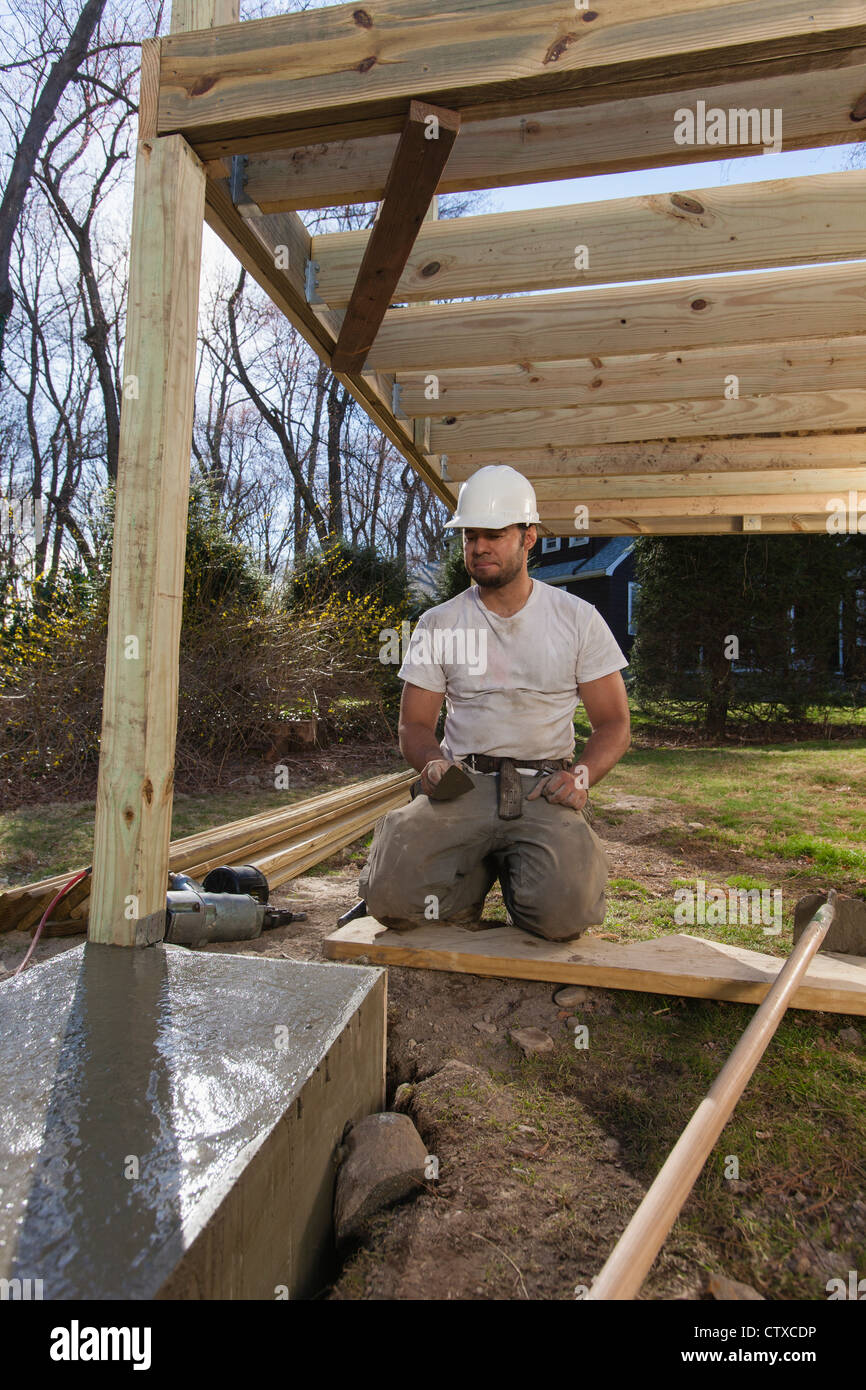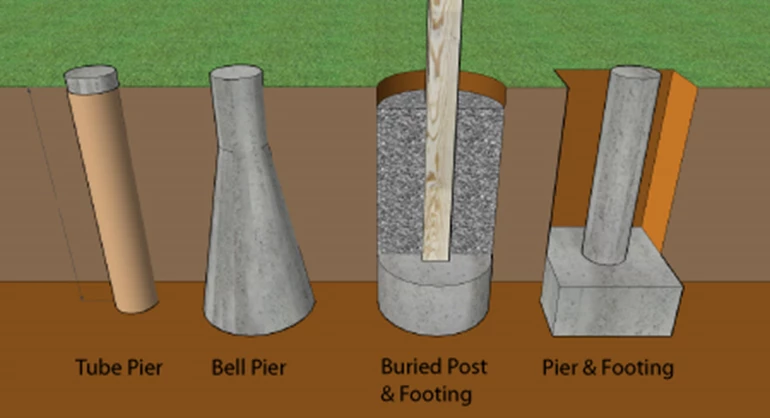Selecting the Right Deck Footings for Stability and Durability
When it comes to building a deck, one of the most vital decisions you will make is picking the best footings for security and toughness. The durability and safety of your deck depend greatly on the sort of grounds you choose, as they offer the vital assistance and security to withstand the examination of time. With a myriad of options available, it can be frustrating to identify which grounds are best fit for your details requirements. In this discussion, we will certainly check out the numerous kinds of deck grounds, consider the vital elements to consider when deciding, and dive into the pros and disadvantages of various options. By the end, you will have a more clear understanding of the choices available and be better outfitted to make an informed decision for your deck task.
Kinds of Deck Footings
These grounds are composed of a round opening filled up with concrete, which gives a strong structure for the deck blog posts. Concrete pier grounds are reasonably very easy to mount and supply outstanding stability, making them a prominent option for numerous deck projects.
Another sort of footing is the helical pile ground. Helical heaps are steel shafts with helical plates affixed to them. These grounds are installed by screwing them into the ground, which develops a safe and secure structure for the deck. Helical stack grounds are excellent for areas with difficult soil problems, as they can be set up in practically any type of kind of dirt. They additionally enable for simple modification and leveling of the deck if required.
Alternatively, some building contractors decide for precast concrete footings. These grounds are made from sturdy concrete and be available in different sizes and shapes to accommodate various deck designs. Precast concrete footings are hassle-free to set up and provide a secure base for the deck structure.
Ultimately, an additional choice is the post-in-anchor ground system. This kind of ground includes driving a steel anchor right into the ground and connecting it to the deck blog post. It supplies versatility in regards to positioning the deck blog posts and is appropriate for decks with light-weight structures.
When selecting the ideal sort of deck ground, it is crucial to take into consideration aspects such as soil conditions, deck load, and regional structure codes (Deck Footings). Consulting with an expert service provider or structural designer can help make certain the suitable ground is picked for a safe and stable deck
Elements to Take Into Consideration When Choosing Footings
When picking the suitable grounds for a deck, it is crucial to very carefully take into consideration various factors such as soil conditions, deck tons, and adherence to neighborhood building regulations. These factors play a substantial role in making sure the security and resilience of the deck framework.
One of the key variables to consider is the soil problems. The kind of soil on which the deck will be developed establishes the kind of grounds required. Decks developed on loosened or sandy dirts may call for much deeper footings to supply ample assistance and protect against settling. On the various other hand, decks constructed on clay or large dirts may need footings that can suit the dirt's propensity to broaden and contract.
Another essential element is the deck load. The weight of the deck, consisting of the products used and any kind of possible online tons such as furniture or gatherings, have to be taken right into account when choosing grounds. The footings should be designed to birth the weight of the deck and distribute it equally to avoid any kind of architectural problems or failings.
Last but not least, adherence to regional building regulations is paramount. Building regulations vary from area to region, and it is crucial to adhere to the certain requirements established by the regional authorities. Deck Footings. These codes ensure that the deck is developed safely and meets the required standards for architectural integrity and load-bearing capability
Concrete Footings: Cons and pros

Concrete footings provide several advantages and negative aspects when used as the foundation for a deck. On the positive side, concrete grounds give outstanding stability and resilience. Concrete is a rigid and strong material that can support heavy lots and endure different climate condition. It additionally has a lengthy lifespan, making it a reputable selection for lasting usage.
One more advantage of concrete footings is their versatility. They can be poured into different forms and dimensions to suit numerous deck styles and setups. Concrete grounds can be tailored to fit the certain requirements and demands of the deck structure.
Nevertheless, there are additionally some disadvantages to utilizing concrete grounds. This can enhance the overall expense of the deck job and might need professional support.

Helical Piers Vs. Sonotubes: Which Is Better?
In taking into consideration the structure alternatives for a deck, the contrast in between helical piers and sonotubes is important in figuring out the remarkable option. They are twisted right into the ground making use of hydraulic machinery, offering a stable and durable foundation for the deck.
The helical plates on the piers produce a strong grasp with the soil, changing or avoiding any kind of motion of the deck. Sonotubes, on the various other hand, depend solely on the concrete filling up for stability, which may not use the same level of strength and resistance.
In terms of installment, helical piers are relatively much easier and faster to set up compared to sonotubes. The hydraulic equipment utilized to twist the piers right into the ground makes certain a quick and effective process. Sonotubes, on the other hand, require digging openings and putting concrete, which can be taxing and labor-intensive.
In addition, helical piers are a more flexible choice. If required, they special info can be made use of in various Home Page soil problems and can be adjusted or reinforced. Sonotubes, on the other hand, might call for extra support, such as rebar, in certain soil conditions or locations with high lots requirements.
Selecting the Right Footings for Your Deck's Dimensions
For optimum structural integrity, it is vital to very carefully pick the suitable grounds that line up with the dimensions of your deck. The dimensions of your deck, including its length, height, and width, play a significant role in figuring out the kind and dimension of grounds called for.
When picking grounds for your deck, it is important to think about the load-bearing ability of the dirt. The weight of the deck, integrated with the weight of any kind of furnishings or individuals on it, puts in a considerable force on the grounds (Deck Footings). Therefore, it is essential to choose footings that can sufficiently support this weight without sinking or changing over time.
Bigger decks with greater measurements require bigger grounds to supply sufficient security and support. The form of the footings, whether they are rounded or square, depends on the design and format of the deck.
Conclusion
To conclude, selecting the appropriate deck footings is important for making certain security and sturdiness. Aspects such as the sort of footings, the deck's dimensions, and the pros and disadvantages of different alternatives ought to be taken into consideration. Concrete footings use strength and durability, but may be a lot more expensive and lengthy to set up. Helical piers and sonotubes have their own benefits and drawbacks. Eventually, choosing the proper grounds for your deck's certain requirements is necessary for a long-lasting and successful structure.
These grounds consist of a cylindrical hole filled up with concrete, which gives a strong structure for the deck posts. Concrete pier footings are relatively easy to set up and use superb security, making them a preferred choice for many deck projects.
Precast concrete footings are practical to set up and supply a steady base for the deck framework.
It uses versatility in terms of positioning the deck articles and is ideal for decks with light-weight frameworks.
Concrete grounds use a number of benefits and downsides top article when utilized as the structure for a deck.